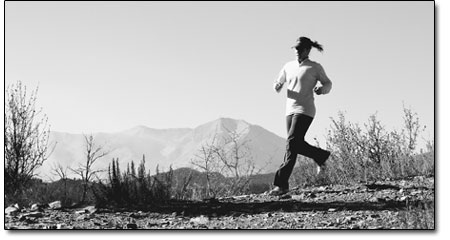| ||
Animas Mountain revisited
by Will Sands Calm has replaced controversy on the slopes of Animas Mountain. A plan to mitigate wildfire hazards on the popular recreation area drew widespread opposition this summer. In response, the Bureau of Land Management has heard the public’s concerns and gone back to square one, having started a full environmental assessment to consider the impacts of fire mitigation. Following the catastrophic wildfire season of 2002 – which included Durango’s Missionary Ridge and Valley fires – the Bush Administration created the National Fire Plan. Among the plan’s mandates was that the Forest Service and BLM thin trees in the Wildland Urban Interface, which is the edge of the forest in proximity to communities and homes. The plan also allowed such fire mitigation to be categorically excluded from environmental review. In response, San Juan National Forest and Bureau of Land Management lands in the vicinity of Durango have been aggressively treated in recent years. The agencies have used a combination of prescribed burning, hand thinning and a relatively new practice known as hydromowing, where a large spinning drum with carbide teeth eliminates small trees and brush. Earlier this year, the BLM announced that Animas Mountain would be the next area to go beneath the hydromower blade. The BLM’s original plan entailed treating 800 acres of gambel oak, piñon, juniper and small-diameter ponderosa pine on the popular recreation area. As originally proposed, the project would have required reconstruction of an old road to create access for forestry equipment. However, that old road is now a trail and makes up approximately half of the greater Animas Mountain loop. Potential damage to the recreational and natural resource immediately incited strong public reactions. “When the BLM conducted public scoping over the summer, we got a lot of response,” said Ann Bond, spokeswoman for San Juan Public Lands. “The first thing we did was extend the comment period, and at that point we got even more public response.” All told, the agency received feedback from 62 different individuals and organizations. These comments ran the full gamut, but most centered on impacts related to road reconstruction. “The major issues we heard related to the need to reconstruct the old road,” Bond said. “People also had reservations about the method of treatment, long and short-term impacts to wildlife habitat and impacts to the mountain’s recreation and scenic qualities.” In response to these overwhelming concerns, the BLM took a voluntary step and has begun a full environmental assessment rather than categorically excluding the project from review. “We determined that there were enough issues being raised by the public, the City of Durango and our own team of specialists that we needed to study other alternatives,” Bond added. The move to go back to the drawing board on Animas Mountain has drawn widespread applause. “I’m glad to hear that they’re heeding public comments and will be carefully thinking about alternative ways to meet their fuels-mitigation needs without disturbing the recreational amenity up there,” said Mark Pearson, executive director of San Juan Citizens Alliance. Despite the environmental assessment, Pearson said that the San Juan Citizens Alliance will continue to keep an eye on the Animas Mountain project. Road reconstruction, in particular, could continue to be contentious. “I think they’re moving in the right direction, but they’re still talking about some road reconstruction,” he said. “That’s really going to be the thing to look at.” Trails 2000 is also pleased that the BLM is taking a harder look at the effects of logging Animas Mountain. The trails advocacy group is especially happy to see the BLM considering smaller hydroaxes and lighter trail impacts. Mary Monroe, Trails 2000’s executive director, said she also hopes that the agency will be looking at ways to enhance the recreational experience on Animas Mountain. “I think it’s good we’re looking at alternatives that include different types of hydroaxes, which won’t require such major alterations to the trail,” she said. “Looking at ways we can improve and enhance the trail through this environmental assessment could also be a positive result.” Katrina Blair, of Turtle Lake Refuge, also voiced objections to the Animas Mountain project, based largely on last summer’s Hidden Valley hydromowing project. Prior to that fuels mitigation, she and members of the Forest Service toured the project area, striking up several agreements and flagging hundreds of trees to be preserved. Many of those agreements were violated and many of the flagged trees were cut anyway in a project that Blair alleged “did more harm than good.” With respect to the Animas Mountain EA, Blair commented, “I am glad that they are going deeper into their studies because the land will be severely impacted by the hydromowing. Hopefully, through the assessment, they’ll realize that the project is not worth doing.” Blair went on to argue that hydromowing is not only impactful but that it actually backfires. Referencing Hidden Valley and other projects, she noted that the brush is growing back thicker and more prone to wildfire than before. “When something is cut by a hydromower, it’s going to regrow in a different way,” she said. “The reality is that the brush is coming back denser than it was. And in the long run that will move us further away from their goal of eliminating fire hazards.” However, Bond countered that reducing immediate fire hazard remains the BLM’s top priority on Animas Mountain, and its proximity to numerous homes makes the need even more urgent. “Just about everyone has to acknowledge that reducing wildfire danger, especially immediately adjacent to urban areas, is the right thing to do,” Bond said. Toward this end, the BLM plans to wrap up its environmental review in coming months. A draft environmental assessment on the project is scheduled to be released to the public in January of 2008. At that time, Durango will have another opportunity to weigh in on the fate of one of its top recreational resources. •
|


